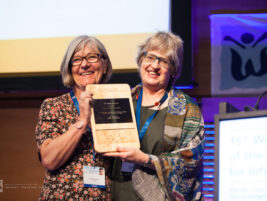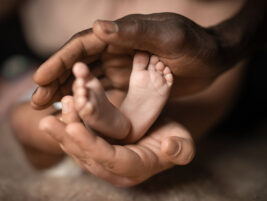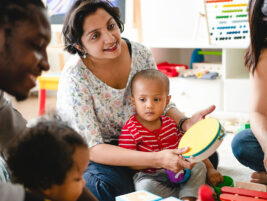The World in WAIMH is a column intended to generate reflection and dialogue about infancy and infant mental health within our global community. Joshua Sparrow, Director of Planning, Strategy and Program Development at the Brazelton Touchpoints Center (Boston Children’s Hospital/Harvard Medical School) conceived of this column. Our shared hope is that this will offer space for challenge and interdisciplinary discussion. We are asking the WAIMH community for commentary, field reports, case studies, research articles, book reviews, new submissions and (when proper permission can be obtained) adaptations of previously published articles that may be of interest.
What follows is a contribution from Astrid Berg, a child psychiatrist and psychoanalyst who resides in South Africa. We selected excerpts from her book, Connecting with South Africa: Cultural Communication & Understanding (2012). We have received permission from the author and the publisher to reprint portions in Perspectives. The book may be ordered from Texas A & M University Press, College Station,
We include passages that invite consideration of differences and similarities in work with very young and families around the world. Of importance, Dr. Berg emphasizes that all infants and children have the status of whole human beings, with a right to be seen and heard and cared for.
Excerpts from Connecting with South Africa: Cultural Communication & Understanding (Berg, 2011) with brief commentary by Joshua Sparrow and Deborah Weatherston.
In chapter two, “And What About the Infant?” the author presents a moving clinical case study in which she illustrates how she works with deep respect for the personhood of the baby, while holding in mind the relationship between mother and child. The case study follows:
“Kwanga was five months old when he was referred to the clinic. His mother was twenty-one years old. His recent failure to thrive was of concern-two months before there had been a marked drop in his weight. Kwanga had had gastroenteritis but had not picked up his weight since then, although the symptoms had ceased.
On history taking, it emerged that he was mother’s first child. His maternal grandmother was living in the Eastern Cape, while his young mother was ‘drifting from aunt to aunt,’ as she had no fixed abode in Khayelitsha. The father of the child was not really present, and she was entirely dependent on the aunts. She stopped breastfeeding when Kwanga was one month old, because the baby ‘did not want to.’ It seems that the bottle feeding and the gastroenteritis contributed to the drop in weight. The mother denied any other problems, saying she loved her baby and that she herself was eating and sleeping well. These few facts we elicited with some difficulty.
We observed that this young mother was well dressed, as was her baby. She would give him a pacifer when he cried (this is a rare habit; usually in Khayelitsha the breast is given for comfort.) Kwanga was quite a thin child. His mother was cut off from him and avoided eye contact with the interviewers and with her baby. I felt that her eyes were ‘drifting,’ like she was with her life. The team had a sense of hopelessness when they heard this story and when they saw the non-interaction and wondered what could be done. Because the mother denied any negative feelings, it seemed pointless to be empathetic.
After a while my co-worker Nosisana took Kwanga, put him on her lap, and talked to him. He needed to be coaxed to respond, but eventually he did so with a smile and physical movements. Hiw mother did not take any delight in this and looked away. However, when her problems were addressed, she did look at Nosisana more steadily. I asked that Kwanga be turned to look at his mother, but he avoided her-he rather looked at us. He was returned to his mother, and now for the first time she held him facing her and smiled at him, and it appeared that he met her gaze. His mother was given a pamphlet explaining the importance of interacting with the baby.
The baby’s failure to thrive was diagnosed as deriving from depression and deprivation in his mother. We hypothesized that the early weaning occurred because there was no older mothering figure to help this young woman. She was asked to return in two weeks. By the second visit Kwanga’s weight had increased, and when Nosisana approached him, he cried, indicating that he had now attached to his mother. He was more responsive to her and more alive. His mother had a ‘lighter’ feel about her and she was interacting with him face to face. She was still living with an aunt, but the relationship with the boyfriend seemed to have stabilized. She spontaneously said that Kwanga looked like his father. This was an important acknowledgement in that the feelings belonging to the father can so easily be displaced onto the baby. This young woman felt more positive toward her boyfriend, and this in turn may have enabled her to have the same feelings toward her infant son.
This case illustrates how even in dire circumstances where poverty and family disconnectedness are so prevalent, and where official social support is so limited, and where the mother seems unreachable and closed off, turning to the infant can result in bringing new life into the situation. The baby was spoken to, he responded to us, and the mother saw this. Something seemed to have changed for her, enabling her to take her baby and do the same for him. His weight gain and his attachment to her were evident during the subsequent visit.
The harder the struggle for physical existence is, the more basic and simpler everything seems to become. In psychotherapeutic interventions, a regular twice-weekly talking session is neither possible nor appropriate. However, the essence of the interaction remains the same whether in Stockholm or in a township in Cape Town: seeing the infant and her or his distress, taking this seriously, and communicating this to the infant. All infants need to be recognized as persons who are eager to communicate.” p. 29-30.
Astrid Berg uses this single clinical case to invite readers to think more deeply about all infants and families and about themselves. She believes that the work with infants leads professionals on a journey in which they discover many things about their own humanity. She ends the chapter with the following comment:
“However, if we start to think about infants as full human beings from the very beginning, who have abilities that allow them to see, hear, and feel in their own right, then the projection and reversal reactions are challenged. If we regard the infant as subject, not as object, we enter another realm of relating and doing psychotherapy (Salo, 2007). We can no longer afford to hide behind defensive reactions such as ‘they are too young to notice.’ The denial has to give way to acknowledgment—and it is a painful, indeed an excruciating acknowledgment. It confronts us with our own beginnings, and we have to imagine what it could be like to be that infant whose mother is not available, who fails time and again to respond appropriately to his needs. From an adult’s perception such a breach may not be that dire; but from the baby’s point of view this maternal failure is experienced as catastrophic (Baradon 2005). We have to use our imagination, as Jan Wiener so clearly invites us to do when working with countertransference (Weiner 2009). In the case of infant psychotherapy it is about finding the words for what we feel that could link to what we imagine the baby might feel.
Once we have understood and integrated the fact of infants as sentient beings, we cannot remain aloof and dispassionate: there is something compelling that draws us into their world, and into what they represent—indeed, it becomes an issue of human rights. Human dignity and justice are not the prerogatives strictly of verbal adults—they extend to the helpless and the wordless; in fact, these vulnerable people require human rights possibly more than anyone else. The feelings evoked in us with infants go beyond the personal. If there is a universal theme that connects us all, it is the way in which we all began this life.” p. 31-32
We welcome letters of reflection and comment from the field in hopes of generating thoughtful discussion about clinical case approaches with infants and families across cultures and in different communities around the world.
References
Baradon, T. (2005). What is genuine maternal love? Clinical considerations and techniques in psychoanalytic parent-infant psychotherapy. Psychoanalytic Study of the Child, Vol. 60, pp. 47-73.
Salo, F. (2007). Recognizing the infant as subject in infant-parent psychotherapy. International Journal of Psychoanalysis, Vol. 88 (4), pp. 961-79.
Weiner, J. (2009). The Therapeutic Relationship: Transference, Countertransference, and the Making of Meaning. College Station: Texas A & M University Press.
Authors
Sparrow, Joshua,
United States






